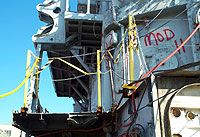Shipyard Employment eTool
Hot Work (including Welding, Cutting and Heating) >> Hot Work in Other Locations

Hot work is occasionally conducted in locations other than enclosed and confined spaces. Such locations may include the exterior of the ship's hull and deck, hollow structures, as well as locations in the shipyard such as shops, dry docks, and tank farms.
The Confined or Enclosed Spaces and Other Dangerous Atmospheres module should be reviewed before continuing with this section. Also, this module, outlining the requirements for Hot Work in Enclosed Spaces, should be reviewed before reviewing the modules regarding hot work requirements for Confined Spaces, or these requirements for Other Locations.


Potential Hazard
Hot work performed outside confined or enclosed spaces also presents potential fire and explosion hazards if adjacent spaces are not properly prepared.
- Welding on hollow structures or containers also presents a hazard.
Requirements and Example Solutions
- Ensure that precautions are taken in adjacent spaces when performing hot work. [29 CFR 1915 Subpart P]
- The shipyard competent person must inspect and test hollow structures and containers such as drums, skegs, rudders, and voids before any hot work is performed. [29 CFR 1915.54]
- Warning: Do not use oxygen for ventilation or cleaning. [29 CFR 1915.51(b)(1)(vi)]
- Ventilate (blow down) or inert hollow structures as necessary before hot work is performed. [29 CFR 1915.54]

Fall hazards are a leading cause of shipyard fatalities. Shipyard employees are often required to work in dangerous environments that may include fall hazards. Accidents involving elevation equipment such as ladders, scaffolds, and aerial lifts are often serious, even fatal. Workers also risk falls from open deck edges.
Potential Hazards
Deck Openings and Edges
- Falls from deck edges
- Falls from deck openings
- Falls into open holes
Scaffolds
- Falls from ladders
- Falls from scaffolds
Requirements and Example Solutions:
Personal Fall Protection
- If fall hazards are identified through the Hazard Assessment required in 29 CFR 1915.152(b), employees must be protected from falls by the use of personal fall protection equipment. [29 CFR 1915.152(a)]
- Guard rails may be used in lieu of personal fall protection, even though they are not required in shipbreaking. For guard rail specifications, see 29 CFR 1915.71(j).
Fall Protection for Scaffold Work
- Guardrails or other appropriate fall protection must be used when working on scaffolds 5 feet above surfaces. [29 CFR 1915.71(j)]
For more detailed information, review Use of Personal Fall Protection Systems.
Potential Hazards
In most cases, respiratory protection requirements are less restrictive in locations other than confined or enclosed spaces, due to the natural ventilation available. However, other workers may be performing work nearby and may expose others:
- Toxic metal fumes, vapors, and gases from welding
- Ultraviolet radiation from arc welding
- "Spatter" from hot metal
- Fire and explosion from nearby operations using flammable or combustible materials
Requirements and Example Solutions
- Provide UV shielding for welding when practical. If not practical, UV filter lenses must be worn by employee at risk. [29 CFR 1915.56(e)]
- Use appropriate PPE for welders and helpers.
- Use airline respirators when welding on beryllium containing base or filler metals. [29 CFR 1915.51(d)(3)]
For more specific information, see PPE Selection: Hot Work.

